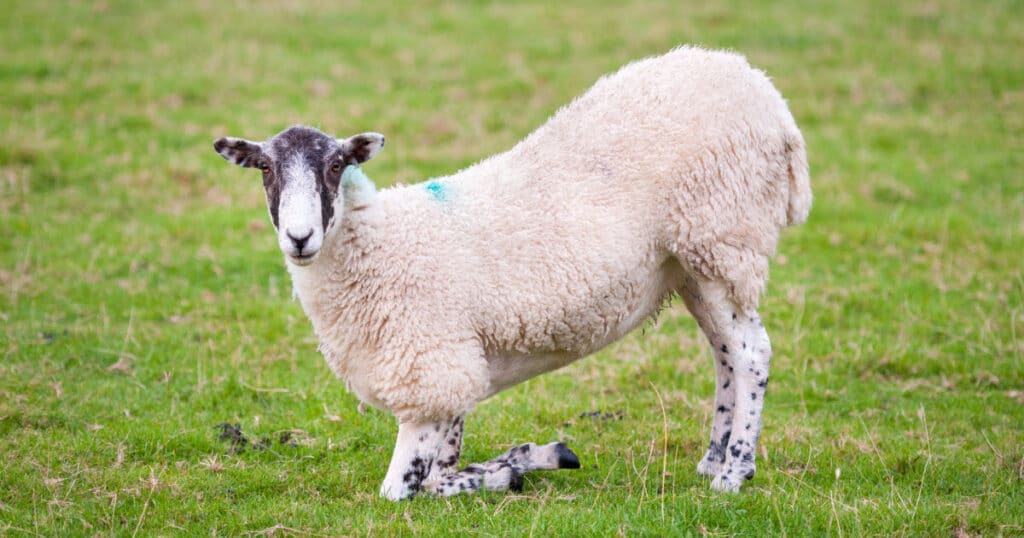Foot Rot in sheep (also referred to as hoof rot, foot scald or hoof scald) is an infectious disease caused by two different strains of bacteria which causes lameness and deterioration of the integrity of sheep’s hooves if left untreated. It spreads rapidly and is extremely difficult (and expensive) to eradicate from a flock of sheep once it is present.
Infectious Pododermatitis (another name for foot rot in sheep) can afflict any animal with hooves and will literally rot away at the hoof. It is extremely painful for the animal. While it can be treated successfully with antibiotics, if left untreated (even for just a few days) it can quickly infect your entire flock.
What Causes Hoof Rot in Sheep?
Fusobacterium necrophorum and Baceroides melaninogenicus – two strains of anaerobic bacteria – are the cause of foot rot or hoof rot in sheep. Anaerobic bacteria can survive without oxygen – an important fact to note as oftentimes it is when mud or bedding becomes lodged in between the toes of your animal that the infection can start to afflict your sheep. Typically there is some injury to the skin or flesh of the sheep between the toes which allows for the initial infection. But if your flock has never been affected by foot rot it’s likely that your exposure will be limited to:
- New sheep which you purchase and add to your flock
- Exposure which occurs at a fair or traveling in a shared sheep trailer (your exposed show animals bring the backteria back to your farm)
- A visiting shepherd carries the bacteria from his or her farm on their boots.
If your flock hasn’t been infected before, it’s most common to observe hoof rot in sheep during the summer months. This is because the warm, humid weather will make the skin between your sheep’s toes more prone to cracking which can allow the bacteria into the foot.
Preventing injury to your sheep’s hooves is the best way to prevent hoof rot.
What are the Symptoms of Foot Rot?
Hoof rot or foot rot in sheep is easily identifiable due to its appearance, foul odor and the obvious lameness of the infected sheep.
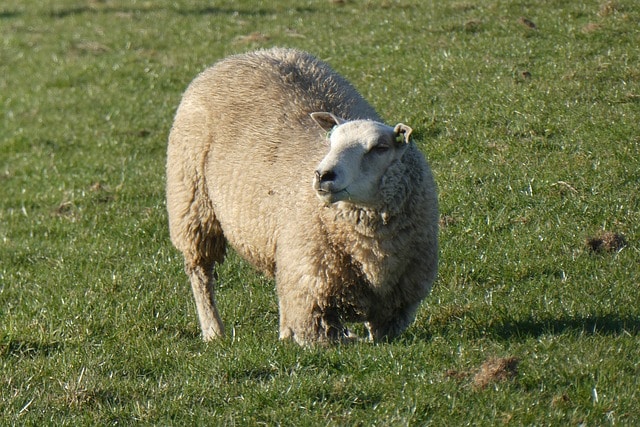
Lameness will usually be the first sign you’ll observe and it’s common to see your sheep limping, holding up one or more of their legs when they graze or stand and/or kneeling to relieve pressure on their front feet when they would otherwise stand.
Upon inspection of the sore foot you will usually observe swelling (cellulitis) between the toes. The skin may be red and sore and a crack can develop in the skin or along an infected part of the hoof which will usually expose the infection which can appear white or yellow in color.
Most shepherds confirm the presence of hoof rot in their sheep by the foul order which, once smelled, is unmistakable.
Treating Foot Rot in your Sheep
If you even suspect that one of your sheep may be showing early signs of foot rot it is important to pull that animal away from the rest of the flock immediately and to observe, diagnose and treat the animal separately.
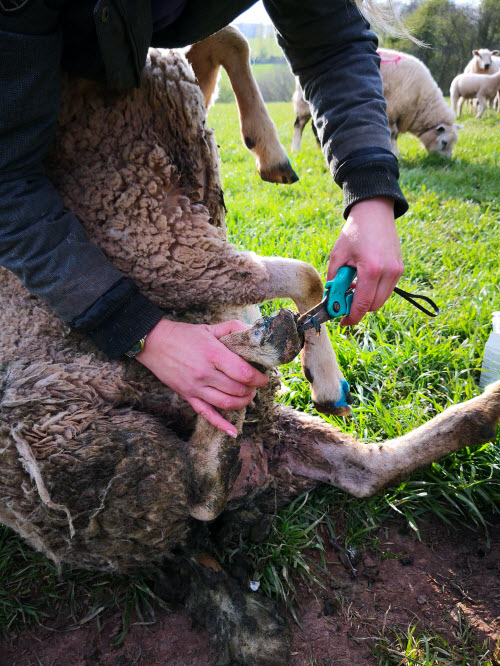
If you ignore a lame sheep for a day or two you may be sorry. When an infected animal remains with your other sheep, your entire flock will quickly become infected. This is dangerous for a couple of reasons:
- Treatment will become very expensive, very quickly – especially for a larger flock. Investing in zinc sulfate, copper sulfate and antibiotics to treat one animal is manageable, but if you have a large flock of sheep the expense can quickly become too much to bear.
- You increase the likelihood that the bacteria will gain a hold in the soil and environment of your farm – something which can cause a constant re-emergence of foot rot in certain types of soil environments, leading to a chronic problem which is nearly impossible to eradicate.
- You risk permanent disfigurement or injury to your sheep – early treatment of foot rot is critical to long-term recovery.
Tips for Treating Foot Rot in Your Flock
Keeping the hoof clean and dry is important during treatment. Topical antimicrobial treatments including administering zinc sulfate (Dr. Naylor’s Hoof ‘n Heel is a popular choice) or copper napthenate/sulfate (Kopertox is the most commonly used brand of copper-based treatment), salves and giving your infected sheep antibiotic injections are the preferred treatments.
A sharp set of hoof trimmers is a must. A dull pair won’t allow you to do a clean job of trimming your sheep’s hooves.
If your sheep doesn’t respond to treatment with zinc or copper sulfate within a few days, consult a veterinarian. If your sheep does respond to treatment, continue to treat the sheep’s hooves for several days after symptoms disappear. This will prevent the foot rot infection from returning.
Recommended Products for the Treatment of Hoof Rot in Sheep:
The Importance of Preventing Foot Rot in Sheep
It’s important to be aware of how long the bacteria which cause foot rot in sheep can live outside of a host. In most environments, if you leave infected pens and pasture barren for a period of 7-10 days the bacteria will have died and you can introduce healthy sheep to the space without risk of infection.
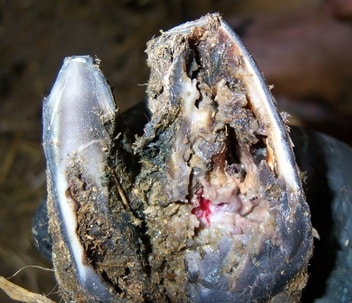
How to Keep Your Flock from Getting Hoof Rot
Many shepherds take precautions to prevent the introduction and spread of hoof rot or foot rot to their farm. These include:
- Have every visitor to your farm dip their boots in a diluted bleach solution to kill any foreign bacteria on the soles of their boots before they enter your barn or set foot in your pastures.
- Separate new sheep in their own pen for a period of at least one week prior to introducing them to the rest of your flock.
- Make an effort to keep your sheep pens, paddocks and pasture in good condition to avoid injury to your sheep’s feet.
- Regularly trim the feet of your sheep but be careful not to trim them too short to allow bacteria to enter your sheep’s hooves.
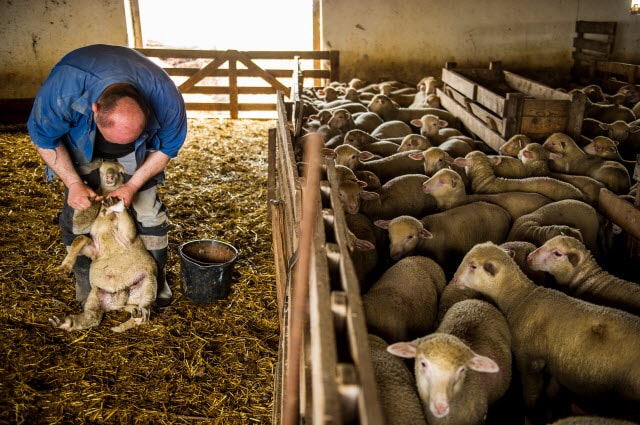
A vaccine has been developed, but shepherds have conflicting views on its effectiveness. Some have reported that administering the vaccine to a flock that has never had foot rot simply introduces the bacteria to your farm environment which can be more trouble than if you simply remain vigilant about prevention. Other shepherds believe that regularly running your sheep through a foot bath of zinc sulfate or copper sulfate can help prevent hoof rot.
If you’d like to learn more about care and maintenance of your sheep flock, join our mailing list or read additional informative articles on this site. We hope that this article about hoof rot and foot rot in sheep has been useful to you and helps you care for your flock!

